What we heard: public feedback summary
Rouge National Urban Park
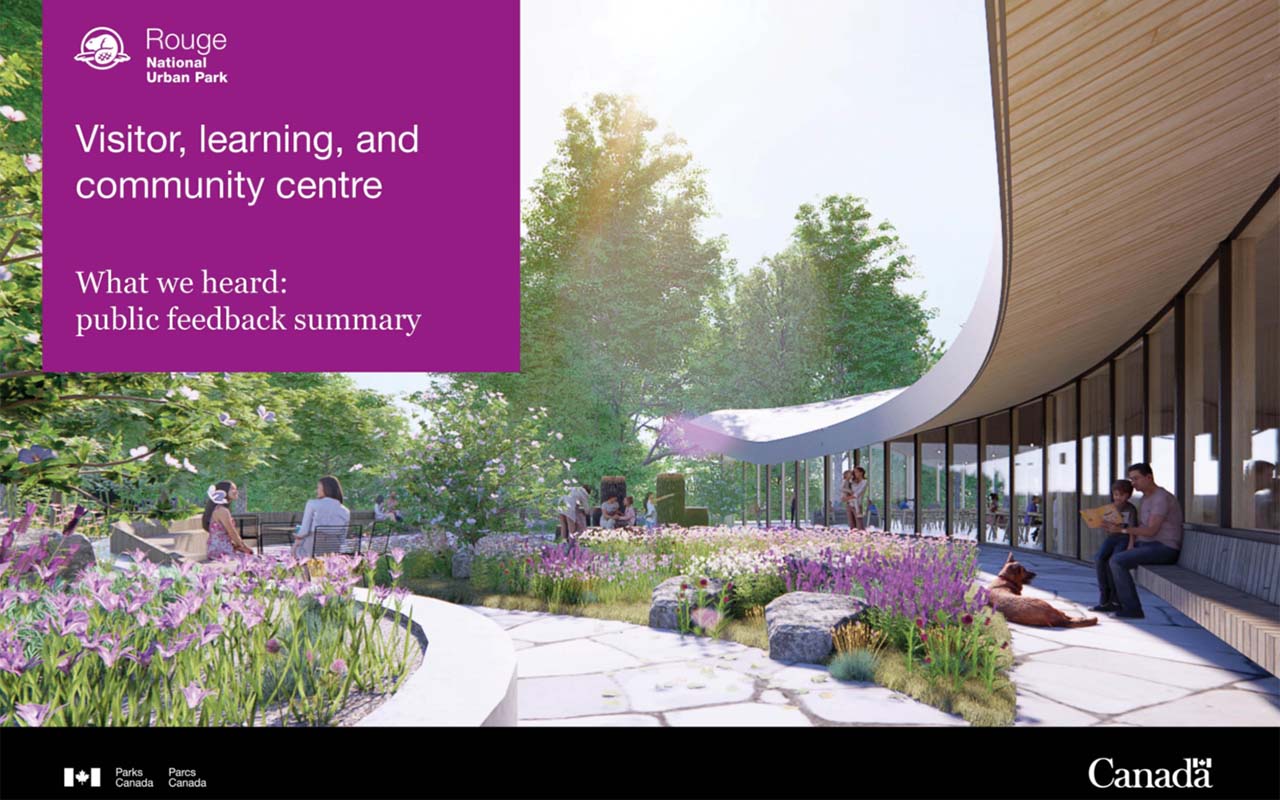
Table of contents
- Introduction: About the park, the project and the team
- About Rouge National Urban Park (RNUP)
- About the new visitor, learning, and community centre
- The consultant team
- Engagement process
- What is restoration?
- Applying an equity lens
- Building relationships with Indigenous community members
- Overarching priorities for the design and visitor experience
Title: Rouge National Urban Park — Visitor, learning, and community centre — What we heard: public feedback summary, July 2022
Organization: Parks Canada Agency
Introduction: About the park, the project, and the team
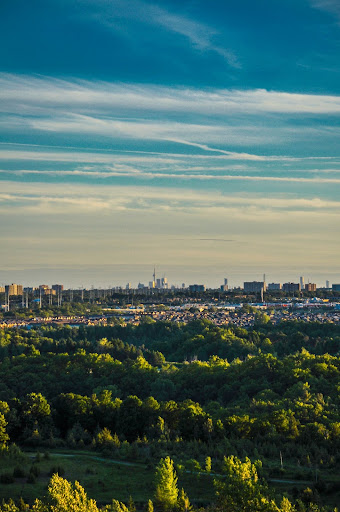
About this report
This report summarizes the key findings from the public engagement process held between July and October 2021 that has helped to inform the final schematic design of the new visitor, learning, and community centre at Rouge National Urban Park (RNUP)
About Rouge National Urban Park (RNUP)
Established in 2015, Rouge National Urban Park is the first of its kind in Canada and the largest urban park in North America. RNUP is a ground-breaking green space initiative for the Greater Toronto Area. Located in Canada’s most culturally diverse metropolitan area, RNUP aims to be a place for youth, newcomers, and urban Canadians to explore and connect with Canada’s natural, cultural and agricultural heritage. Linking Lake Ontario with the Oak Ridges Moraine, RNUP offers engaging and varied experiences, inspires personal connections to its natural beauty and rich history, promotes a vibrant farming community, and encourages us to discover Canada’s national treasured places.
About the new visitor, learning, and community centre
Parks Canada’s vision for this project is to create a flagship visitor hub with multi-purpose gathering spaces and visitor amenities. The site will function as an iconic gateway to both Rouge National Urban Park and Parks Canada. It will feature a universally accessible building and an outdoor event space with a learning focus on Indigenous, natural, cultural and agricultural heritage through integrated interpretive installations and design elements.
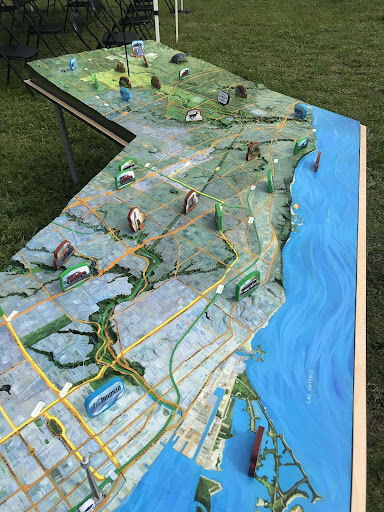
The consultant team
Architecture and Engineering
Toronto-based architecture firm Moriyama & Teshima Architects has partnered with Six Nations of the Grand River-based Two Row Architect. The landscape architecture of the site is being curated by Toronto-based Studio Ian Gray.
Visitor Experience
Montreal-based firms cadabra and Daily Tous Les Jours are collaborating on visitor experience and interpretive design.
Public Engagement
Public engagement was designed and facilitated by Toronto-based engagement, research and strategy studio PROCESS.
Engagement process
Previous engagement
Throughout 2020 to early 2021, Parks Canada conducted extensive co-design with RNUP First Nations Advisory Circle (FNAC) and Indigenous co-creators, as well as stakeholder engagement with RNUP farmers, RNUP staff, the Friends of RNUP and Waterfront Regeneration Trust (WRT) to develop visitor experience concepts and inform the building and site plan. Key stakeholders will continue to be engaged throughout the lifecycle of the project.
Building on this engagement, Parks Canada enlisted PROCESS to support larger-scale public engagement and get feedback on the early concept options to influence the design.
Engagement objectives
The public engagement process aimed to engage a broad spectrum of Rouge National Urban Park users and members of the public in the design of the new visitor, learning, and community centre.
Specific objectives were to:
- Share the process and project already underway
- Continue to build community capacity and stewardship of the park
- Collect feedback on the visitor experience (VE) program and architectural design concepts from key target audiences and future users
- Ensure the public engagement process is equitable
- Demonstrate transparency and accountability throughout the project
How we engaged
Throughout the summer of 2021, over 1,000 community members were engaged, using the following strategies:
- 1000+ on-site engagements gathering feedback on design options and experiences
- 398 online survey respondents gathering feedback on design options
- 17 workshop and interview participants focused on equitable and inclusive visitor experience
- 986 total unique page views on project webpage
What is Restoration?
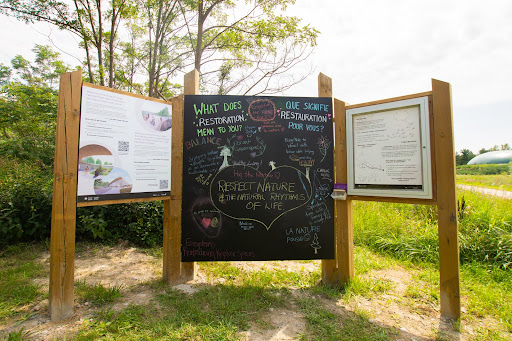
The Big Idea: Restoration
The Rouge is a powerful restorative force, one that continually inspires renewed ways of living with nature and one another.
Restoration is the overarching concept being explored through the design and experience of the site.
What does ‘restoration’ mean to visitors?
- Restoration is about connection to nature.
- It’s about restoring mind, body, and spirit, through individual reflection, movement, celebration, and food.
- People want a solitary escape, as well as communal activities.
- Restoration is tied to reciprocity.
- There are some negative associations with restoration, because it can be seen as romanticizing the past without recognizing historic injustices.
Bringing nature and people together in an accessible and sustainable way.
Restoration is difficult... It implies that relationships were good. Restoration means to go back to... to return to... should we not renew? We can't change things, there is so much history in between the past and the present that we must acknowledge.
Food brings people together, and in the Toronto context it's the ultimate celebration of our vibrant cultural diversity. I find gathering around food to be restorative in that it transports you back and helps create new food memories.
When sharing and experiencing other cultures it's also revelatory, and brings deeper understanding, learning and appreciation for the uninitiated.
I’m very social but in order to restore, I need time in peace & quiet alone time.
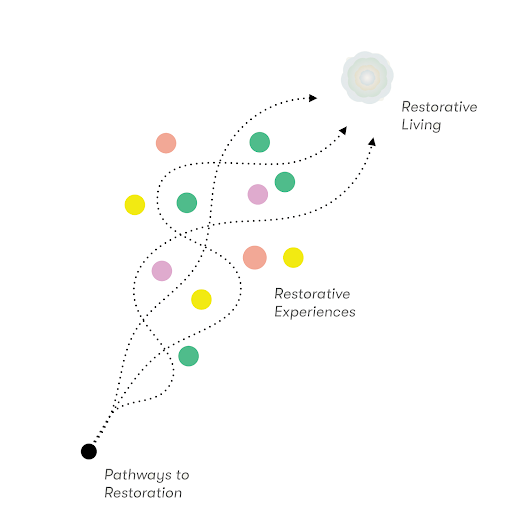
Incorporating restoration
Engagement raised many nuanced, expansive definitions of restoration, referencing a connection to nature, restoring the mind, body, and spirit, storytelling, and building a sense of community.
The architecture, landscape design, and visitor experience will reflect the enriched understanding of restoration, offering visitors opportunities to follow diverse pathways to learn about the Rouge and deepen their relationships with the natural environment.
Equity lens
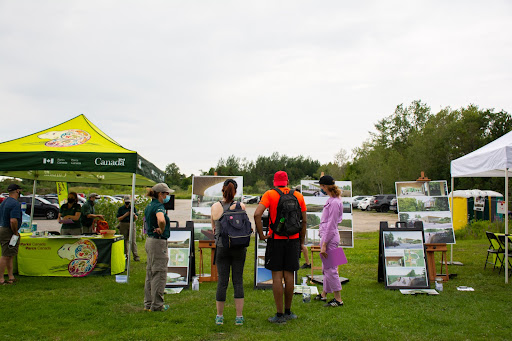
Applying an equity lens
Parks and public spaces can be experienced differently by different people, depending on their race, gender, ability, income, and more. At the same time, public engagement on parks and other public spaces often attracts those with privilege, access, and time, leaving other voices unheard.
To better understand how this project can be inclusive to people with a diversity of experiences, and especially those with under represented perspectives, PROCESS and Parks Canada used a Gender Based Analysis Plus (GBA+) framework. The GBA+ framework includes perspectives on intersectional experiences of gender, sexual orientation, race, culture, mental or physical ability, and more. The four key identities prioritized for the project are Indigenous people, neighbouring racialized families, people with disabilities, and LGBTQ2+ people.
Building relationships with Indigenous Peoples
To ensure that the design and programming of the visitor, learning, and community centre at RNUP reflects the past, present, and future of the land and culture of the area, this project is being closely co designed with representatives from the ten First Nations that constitute the Rouge National Urban Park First Nations Advisory Circle. Urban Indigenous groups within the GTA, such as Native Child and Family Services of Toronto (NCFST), were also engaged.
PROCESS facilitated connections between Parks Canada and local Indigenous artists and entrepreneurs through a workshop, gathering ideas for collaboration and procurement of art, food, landscaping services and more. The goals of engagement were to learn about the diversity of Indigenous perspectives and build longer term relationships and explore collaborative partnership opportunities.
Overarching priorities for the design and visitor experience
The public engagement process resulted in five key principles for integration in design and programming.
Principle 1 - Feel nestled in nature
Both in person and online, participants commented regularly that they would like to feel nestled” in nature.
Some attributed this feeling to an experience of an elevated view of nature and trees, while others noted excitement about the sense of an overall relationship to the natural environment. Design that is subtle and aesthetically pleasing contributes to feeling both inspired by the natural environment and safely protected from the elements. The feeling of being “nestled” in nature relates to feeling immersed in nature.
Connect to the trees.
The word “nestled” was used 10 times in the survey responses to describe the feeling of connection to nature and trees. This relates to ideas of contemplation, designing aesthetically pleasing locations for lookouts or viewing platforms, and being within the trees.
Ensure nature access in all seasons.
The indoor space can create the feeling of being in nature while being protected from the elements in winter.
I like how [the proposed visitor centre] is situated around the greenspace and has a lookout, and is enclosed for the winter weather.
Critically important: Please leave space for quiet and solitude to walk alone and enjoy nature.
Create options to be alone and options to be together.
There is interest in both collective and individual programming options.
- Some people want a solitary escape. Many viewed solitary interactions with nature as more restorative than gatherings or other collective activities. They felt that restoration is tied to the concept of escape. The Rouge represents a place to enjoy a reprieve from the fast pace of daily life in a densely populated urban environment, where the desire for a peaceful, quiet, and contemplative moment to coexist with nature can be fulfilled.
- Some people want a communal experience. There is also interest in collective activities like guided tours, community gardening, and picnicking. It is important to ensure visitors feel they have a choice when they arrive, and that some spaces will remain somewhat undisturbed by nearby programming opportunities.
Principle 2 - Create space for community life
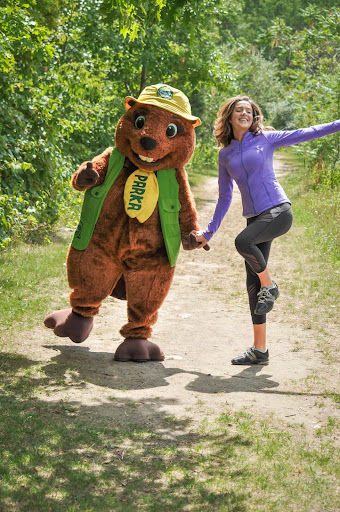
The site can be promoted as a destination that welcomes and supports the needs of local communities , drawing people from near and far, and providing a space to create deeper social connections through programming.
For example, events and community pop ups could support small businesses and groups showcasing and selling local food, culture, and art. This creates an asset in which local community members can take great pride.
A place to organize community events centred around restoration (e.g. tree plantings or other similar activities) to involve the community in…the park.
Include community hikes, community trail runs, [and] charitable
Farmers’ markets hosted within the park would be very cool or community gardens to harvest or workshops on how to grow certain vegetables and plants, especially focused on those who have limited space and sunlight.
Principle 3 - Centre local and diverse communities
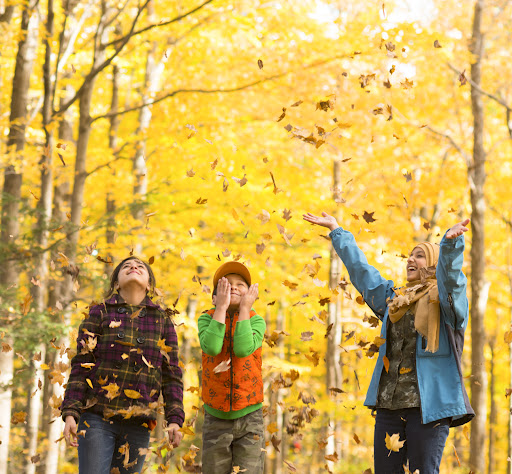
Many local community members from equity deserving communities, particularly Indigenous, Black, and other racialized community members, shared that they want to see themselves and their experiences reflected in signage, art installations, and among park staff. This supports their feeling of being both safe and welcome at RNUP.
Programming for us, by us.
Participants want to see programming designed and led by Indigenous, Black, and other racialized community members.
Show diverse examples and visuals.
It’s not just s’mores and burgers that are made over fires. When we communicate about campfire and hiking activities and programming, share examples and images of diverse cultural practices and offerings.
Learn from local communities.
There is an opportunity to explore the use of local commercial and cultural landscapes as inspiration for food. For example, the gift shop or food offerings could cater to a diversity of cultures found in the near vicinity.
Hire local and diverse staff.
Build a team of on site staff, programmers and facilitators that reflect the cultural diversity and diversity of experiences in the surrounding area.
Ensure opportunities on site are affordable.
Affordable programming, food offerings, equipment rentals, and other outdoor activities can improve park access for a diversity of users, including newcomers.
Step in various shoes and perspectives Child, teen, adult, senior, disabled, impaired.
Rentals of equipment is big. Outreach to new Canadians. Perhaps events specifically for newcomers.
Principle 4 - Co-design with Indigenous partners
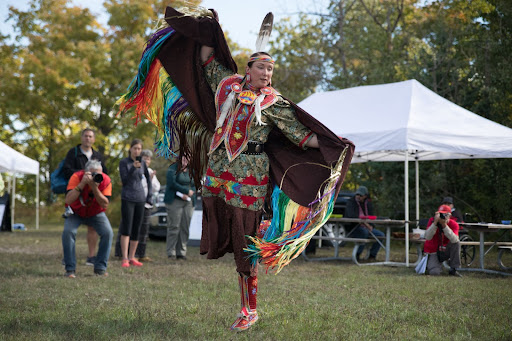
Recognize Indigenous presence, here and now. It is important to create spaces for Indigenous peoples to craft their own visions and tell their own stories. These stories will not just speak to the past, but will speak to the presence of Indigenous peoples now, and into the future.
Indigenous partners play a crucial role in defining the design and program of the space, and in ensuring its successful path forward.
Ensure equitable access for Indigenous peoples.
We registered the importance of exploring different ways to reduce access barriers for Indigenous people looking to use park lands in ways that are culturally meaningful.
Include stories of stewardship.
Sharing current examples of Indigenous stewardship of the land was deemed important. Participants shared the importance of showcasing Indigenous knowledge and expertise about plants, animals and other features of the area, through Indigenous led and designed programming.
Meaningfully incorporate Indigenous languages.
Participants shared that it is important to meaningfully incorporate Indigenous language into design and programming. They suggest going beyond merely direct translations of keywords on signs, and instead, incorporate creative opportunities to learn about and hear Indigenous languages on site.
Develop opportunities for Indigenous procurement.
Participants identified opportunities to collaborate with Indigenous vendors, artists, and naturalists to design food, wayfinding, art, and programming opportunities. This includes suggestions to hire Indigenous staff to teach about the land, medicinal plants, animal, and more.
Tell Indigenous stories in new and relevant ways.
Let Indigenous nations actually have decision making power in this process.
Principle 5 - Prioritize access and connection
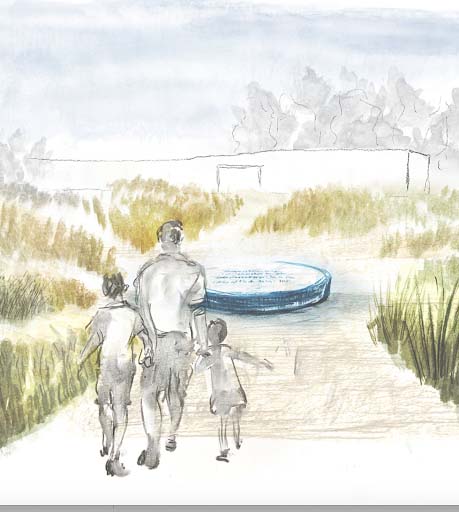
Participants want to access and experience the park in many ways, including on foot, by public transit and car, by bike, and using mobility devices such as wheelchairs.
Many park visitors are newcomers to Canada. This means many are first time visitors to the park, and may not be familiar with its landscapes. Once they arrive, they need clear, well marked signs and paths in order to access the park easily.
Provide clarity and options at different scales.
Guided tours, clear and translated signage, and clearly marked short, medium, and long trail options can help first timers feel comfortable venturing out. Signage that points out activities (such as spots for picnics or lookouts) can make a hike more stimulating.
Create instagrammable moments.
Destinations that serve as photo opportunities will motivate new and long time hikers alike to visit, particularly those who are young and social media savvy.
Support multimodal experiences.
Visitors want to have options to access and experience the Rouge in many ways, including cycling, on foot, and by transit.
Build bridges to local communities through partnerships.
Build relationships off site. Opportunities to partner with local organizations can help to facilitate and plan park access for communities that have historically faced barriers to accessing green spaces.
Partner on site. Develop local stewardship opportunities by incorporating community / non profit partners on site. There are many successful local examples of partnerships between green spaces and non profit organizations. Non profit partners can promote awareness of and respect for nature and could offer year round, hands on, outdoor nature education and park stewardship.
Thank you for sharing your feedback and ideas with Parks Canada and the rest of the project team. The principles reflected in your feedback will continue to be referenced and incorporated throughout the design development process.
We are excited to share updates on this project as it progresses, and look forward to seeing you in Rouge National Urban Park!
Related links
- Date modified :